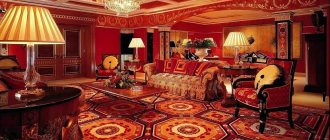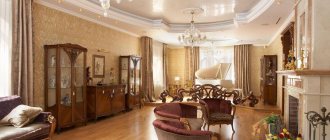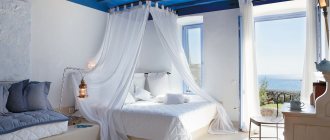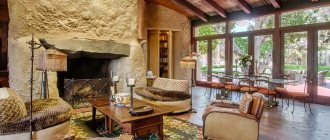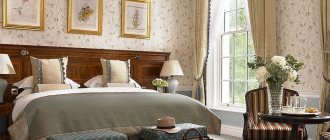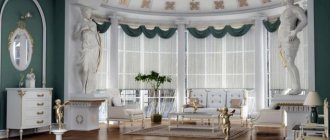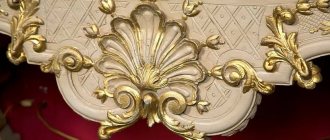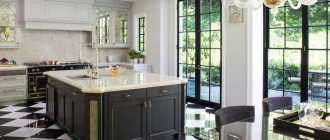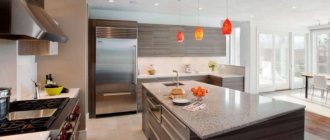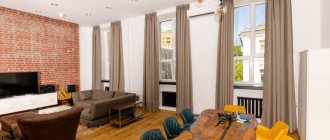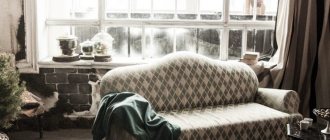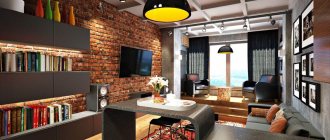History of the emergence of Art Nouveau
The emergence of this style was provoked by that incredibly chaotic eclecticism, which at the end of the 19th century became the most commonly used in the design of European interiors. All styles known at that time were mixed, shuffled, piled on top of each other, but did not give a new result. The rooms remained the same recognizable, long tired of, did not differ in any originality or classical purpose, they were just a repetition of previous designs, often in a not very successful combination.
The emergence of a new style was a natural process, accelerated by the rapid development of new technologies that required their implementation. At first, Art Nouveau design was perceived as a sign of bad taste and appeared in few houses. Mostly, it was resorted to by extraordinary individuals who wanted to stand out from the crowd in this way.
Modernism did not last long at the peak of popularity. Its decline began in the second decade of the twentieth century. This was due to the high cost of manufacturing furniture and finishing materials necessary for the purity of the style. The development of industry, which put the production of objects on the assembly line, finally shook the foundations of the style, and the First World War put an end to its popularization.
Modern in different countries
The new progressive and very bold style quickly spread throughout the world, finding millions of fans. In each country it has its own name:
| In America it is Tiffany. Named in honor of the famous artist and designer L. K. Tiffany, the author of the original glass connection in stained glass production. |
| For the French, this is Art Nouveau, which means “new art”. |
| “Young art” or art nouveau among the Germans. |
| Modern style from the British. |
| Secession among the Austrians. |
| Liberty for Italians. |
| Modernism among the Spaniards. |
| Spruce style in Switzerland. |
Each culture left its mark on the development of style, and soon two main directions appeared: decorative and constructive. The first was typical for Scotland and Austria. The second was followed by Germany, Belgium, and France. The Russian style can be identified as a separate group, the development of which was strongly influenced by folk traditions. But this division is very conditional. It is not for nothing that designers consider modernism the most complex of all known styles - it has absorbed such a huge number of trends, been influenced by so many cultures that it is sometimes very difficult to determine the line between it and eclecticism or art deco.
Materials for the design of apartments and houses in the Art Nouveau style
The main material that designers use to decorate rooms is wood. It is better to choose noble breeds with unique natural patterns. Most often, beech and oak appear in interiors. The durable wood of these species is famous for its performance qualities. The wood undergoes minimal processing, as natural textures are encouraged.
Metal is also often used in design. It appears in the form of forged elements on pieces of furniture or building facades. In order not to overload the environment, designers introduce this material in very measured doses.
Textiles occupy a special place in Art Nouveau interiors. It can be presented as:
- Luxurious straight curtains.
- Upholstered furniture upholstery.
- Carpets with fancy patterns.
- Sofa pillows.
Textiles are important, but there should not be a lot of them - they are used only as design accents. Such details complement the stylistic picture without distracting attention from the key elements of the decor.
Distinctive features of the Art Nouveau style
Each style has its own distinct differences, allowing even a barely knowledgeable person to accurately identify them.
Modernism in the interior is:
#1. An abundance of wooden elements. The interior in the Art Nouveau style does not accept non-natural materials. The most affordable and versatile is wood. It is used to create furniture, wall panels, decorative elements for walls, ceilings, flooring, windows and doors. The most commonly used wood is hardwood with a pronounced structure: beech, oak. When processing it, dull painting, which hides the structure of the fibers, is not allowed.
#2. Complete absence of straight lines. Smooth, soft contours, without any angles, often imitating plant elements.
#3. The shapes are smooth, devoid of any symmetry. Harmonious flow from one to another. Vertical dominant.
#4. Natural themes in decor: stylized plant and animal patterns. Initially, Art Nouveau gravitated towards a simplified image of lilies, petals and leaves, butterflies and dragonflies. But today these elements are not mandatory. You can select them according to your own taste.
#5. Stained glass used to decorate windows, doors, ceilings and lamps. The technique of their manufacture is not important - from expensive Tiffany to pseudo-stained glass created by painting. Only the theme of the drawing is important. It should be in tune with the general mood of the room. Most often this is a floral design using flexible stems, soft petals and smooth abstraction.
#6. Windows rising upward, often arched or huge, such as display windows, decorated with floral decorations. In the Art Nouveau style, windows are used not only for their intended purpose, but are also a full-fledged element of the decor of the room, complementing, and often putting an end to its design.
#7. Doors are rectangular or arched. Wide, preferably double-leaf. Flat, with elements of mosaic decor. A distinctive feature of Art Nouveau doors is the windows on the top and sides of the doorway, most often decorated with stained glass. This creates an additional feeling of open space.
#8. The stairs and steps are wide, always decorated with forged railings with openwork patterns.
Entrance door decorated with stained glass in Art Nouveau style.
Staircase in Art Nouveau style.
Materials
The Art Nouveau style in the interior is characterized by some retrospectiveness. At the time when this style appeared, there was not such an abundance of light plastic that surrounds us now - and it is precisely due to its absence that modern interiors look so luxurious and even a little monumental.
This nature of the style dictates its own rules - only natural materials should be used in the interior. The combination of precious wood, glass, ceramics, and elegant forged elements creates a space that is unique in its sophistication. Yes, this is far from a budget option; high-quality implementation of interiors in the Art Nouveau style requires significant investment. But the result is worth it - the house takes on a special luster and a very noble appearance.
You should not try to replace high-quality, expensive materials with simpler, modern analogues. The essence of modernity is precisely that all objects are valuable, and not just look so at first glance. Upon careful examination, the origin and quality of each element will still be noticeable, so you need to pay attention to the materials first.
Features of room layout in Art Nouveau style
Modernism tends to have a lot of free space, so a medium-sized or larger room is suitable for design in this style. It is best if it is a studio apartment. Its layout allows you to unobtrusively zone the space, using only floor coverings and ornate openwork partitions with necessarily wavy arcuate lines.
The dividing line on the floor should not have corners and be smooth. Zoning lines can be duplicated with partitions, furniture, carpets, large decorative elements and even floor patterns.
The second option, which best suits modern design, is an apartment with a non-standard layout. This arrangement is most suitable for creating an interior that gravitates towards non-standard and asymmetrical shapes. After all, with the help of Art Nouveau you can veil the unfortunate shape and arrangement of rooms.
Fireplace
Due to the holistic perception of the interior, fireplaces have not played such a role in any other style. This is the largest element of the decor.
Source: .admagazine.ru
Art Nouveau architects turned it into a gigantic complex structure, using entire sculptural compositions or spectacular paintings as frames. Art Nouveau fireplaces are a self-sufficient decorative element, and often a true work of art!
Source: pinterest.com
Source: apartmenttherapy.com
Style color scheme
The naturalness of the material used to create a modern interior is emphasized by natural colors.
All of them should be muted, not flashy, in pastel colors:
Shades of brown.
Pearl.
Wet asphalt.
Beige.
Silver.
Black.
The purpose of color is to give the interior lightness and romance.
Suitable for contrast:
Red.
Yellow.
Fuchsia.
But there should be a small number of these accents.
It is important to choose the right balance of colors for decoration, furniture and textiles so that the room creates the impression of a single whole, and not a mixture of disparate elements. In modernity, which allows for all sorts of deviations and innovations, such a fragile line is very easy to miss. As a result, instead of a stylish interior, you get the same eclecticism, and often of very poor quality.
First of all, it is necessary to determine the accent element, and only then adjust the background and additional color fillings to it. If it is necessary to draw attention to luxurious furniture, the color of the walls, the richness of the stained glass windows or the pomp of the ceiling decoration should in no case interrupt it. Be proud of the designer stained glass windows on the windows, ceiling and doorway - furniture, walls and floors should be made in pastel colors of one or two colors in different tones. You should not use too many colors - after all, we are creating an interior that is comfortable for the eyes, and not a rainbow, even if all its colors are harmonious with each other.
In modernism, which gives preference to space and air, excluding additional partitions, you can use color to zone a room. The main thing is that all elements of each zone are consonant and in no case conflict with each other. You can experiment with the color scheme of each zone at your own discretion, remembering to adhere to the basic color requirements.
What the Art Nouveau style looks like: the distinctive features of the direction
The main highlight of modern interior design is the contrast with classics. The furnishings should be practical, beautiful and modern. You should try to avoid clear lines and pompous details. Here are a few more features of the direction:
- Asymmetry in the setting.
- Massive objects combined with laconic ones.
- Bright lighting.
- Finishing with natural materials.
- Non-standard design options.
- The use of stained glass.
- Floral motifs in decor.
- Maximum open space.
An example of the Art Nouveau style in the interior
. Important! Art Nouveau style is a good solution for apartments with a non-standard layout. It will not be difficult for designers to implement fresh ideas in the best traditions of the direction.
Art Nouveau walls
The walls create only a background, but in no case draw attention to themselves. Therefore, to paint them, light, non-flashy shades are used: pearl, cream, milky white, light gray. Texture is unacceptable. For some rooms where it is necessary to create a certain intimacy and intimacy, you can take darker tones of wine and brown.
They should be muted, without gloss. To avoid excessive gloom from a dark color, the walls can be decorated with discreet floral patterns. Its distinctive feature is its vertical arrangement, simulating the natural growth of plants.
Sometimes designers prefer to decorate the lower part of the walls with wood panels, which in some cases is more practical, for example in the hallway. The panels should be made of natural wood or, in extreme cases, a cheaper artificial material that imitates it. The upper part of the walls is covered with silk or paper wallpaper in pastel shades. In any case, the decorated walls should not attract attention, thereby drowning out the interior decoration of the room.
No. 6. Modern room lighting
Most interior styles dictate an abundance of sunlight and artificial lighting. With modernity it's the other way around. The light here should be dim, warm, cozy . Imagine a sunny day in the forest, when the tree crowns allow some of the rays to pass through, and they softly flood the space. The light should be romantic, and the glare of the sun will help convey the stained glass.
Lighting is multi-level. Let the central element be a forged multi-arm chandelier; its design may include elements made of frosted or colored glass. Instead of the usual chandelier or together with it, you can arrange interesting ceiling lighting by hiding compact lamps behind the ceiling stained glass window. You will be able to fully convey the spirit of the style, even if some other elements cannot be repeated.
In addition to central lighting, wall sconces and table lamps are used. The legs of floor lamps are made of wood or metal, they are distinguished by curved shapes. Lampshades are made from colored glass, fabric, porcelain, and forging elements are used.
Ceiling decoration in Art Nouveau style
The ceiling in the Art Nouveau style should be given special attention. Unlike the walls, it is very richly decorated. This can be voluminous gypsum stucco or wooden elements. It is in the ceiling that the influence of the classics on the formation of this style is most felt. Its static elements fit very organically into the outlandish interweaving of wavy lines and look great in asymmetry, smoothly weaving through the rooms in a dynamic pattern.
Stained glass windows are often placed on the ceiling, which are an invariable and very important attribute of Art Nouveau. Illuminated with muted light that does not hurt the eyes, they create a special mood in the room. Moreover, a stained glass window made according to the owner’s own design is a great way to express yourself and make your personal contribution to the design of the room.
Modernism in the interior: history of style
Another name for the style is “art nouveau”. Translated, the word means “modern.” Designers call this direction one of the most complex and controversial. Art Nouveau trends were actively developing before the outbreak of the First World War. The specialists wanted to create something fundamentally new, holistic, luxurious. And they succeeded. Modern designers actively use this direction as a fundamental one to express impeccable taste in the interior.
The style originated in England at a time when furniture and decorative items became more affordable. People sought to move away from strict aristocracy and breathe more freedom into decoration. It was Art Nouveau that became the basis for such a movement as abstractionism. Now some designs organically intertwine the best features of these styles.
Art Nouveau style in the interior
Art Nouveau floor
Flooring is a very important component in the design of a room of any style. In modernity, gender is not an active component. It should fit harmoniously into the overall picture, not suppress or “disappear.” Setting off the decoration of the room, it can be darker than the walls or in the same tone.
The floor allowed by the rules of modern modernism in the interior is wooden parquet, laminate, natural tiles or stone. The parquet can be laid out in a classic herringbone pattern or in a specific design with the obligatory smooth lines of the pattern. Laminate should be in natural colors similar to a wooden board. Modern technologies make it possible to create a design laid out from natural stone or porcelain stoneware, carved in any shape.
Classic floor design in Art Nouveau style.
Style furniture
Furniture in Art Nouveau style interiors must meet two seemingly mutually exclusive requirements: to be as different as possible from products of classical forms, but at the same time not to be too futuristic. Moreover, it should be compact, but at the same time functional... however, in modern designs, compact furniture is often complemented by some massive interior objects - this allows you to create a more textured, more “catchy” image.
Art Nouveau style in the interior of the living room
Art Nouveau fireplace
Selection of furniture
Furniture that is correctly selected in style is convenient, comfortable, with smooth outlines. It should beckon you to rest. Complete absence of any corners. Sofas and beds have maximum asymmetry in the backs. The backs of the chairs tend upward in strange waves. The proportions of cabinet furniture are as dominant as possible towards the vertical.
Modern is a very flexible style, so classic furniture with a bizarre shape will fit perfectly into it. Furniture in a minimalist style is also suitable for it, if it is complemented with appropriate decor, expressive patterns and stained glass details. The main rule in choosing furniture, from which you cannot deviate, is natural color and material.
The amount of furniture should be clearly designed taking into account the purpose of the room. An excess of objects is not allowed, creating clutter that is not acceptable for this minimalist style that requires a lot of air. Upholstered furniture is not a modern item, but in some rooms it is necessary. It should be as small as possible, only for the intended purpose.
In terms of color scheme, it should fit into the overall picture; wood should radically predominate over textiles. The textiles themselves are made in muted pastel colors. Among standard industrial upholstered furniture, you should select items with a minimum number of corners, rounded soft armrests, discreet textiles and floral patterns.
Furniture in Art Nouveau style.
Furniture
Art Nouveau furniture is usually made of carved wood. It is decorated with images of flowers, cartouches (inserts) in the form of female heads, symbolizing nymphs and naiads, river fairies. After all, the element of modernity is water, hence the fluidity of lines and images of flora and fauna, as well as the main characters.
Source: pinterest.se, mosans.lv
Furniture - the most bizarre shapes. The leading motifs of the style are recognizable: a horseshoe, a curved line, the so-called “blow of the whip” (it is believed that it was this that gave birth to this whimsical form), plant stems, an elegant female form.
Source: pinterest.com
Lighting
For modernism, lighting fixtures, their appearance and location, are important. In this case, it is better to adhere to the classical rules. They will allow you to emphasize that the interior belongs to the style, even if there are minor flaws in the rest.
A ceiling lamp in the Art Nouveau style is a permanent chandelier with the obligatory crystal decorative elements, luxurious and eye-catching. All its metal elements are gold-plated or forged. For bedrooms and boudoirs, you can use a chandelier made in Tiffany stained glass style. Multi-colored glass, shimmering with fancy reflections from the turned on light, will become a bright accent spot in the room.
It is desirable that floor and table lamps have something in common with the chandelier in their design technique. The base and legs of floor lamps should be made of natural material, metal or wood, and not fall out of the overall color scheme of the interior.
Additional lighting in the form of wall lamps is possible. They are often used for zoning. Their base should be made of natural material, and the lampshades should be conical or round in shape.
All lighting fixtures have a complex shape, possibly with decorative elements in the form of intricate monograms, flowing plant elements, asymmetrical and elegant due to their ideal lines.
Modern chandelier in Art Nouveau style.
Decor
The main decorative elements in Art Nouveau style interiors are wall panels, abundantly decorated with carvings, stained glass windows, which are used not only to decorate facades, but also inside the building - they decorate doors and flights of stairs, for example, as well as tiles.
Source: subscribe.ru
Source: liveinternet.ru
The latter is bright, colorful, with many small details. The main motif of the pattern decorating it is images of flowers - primarily water lilies, birds, dragonflies.
Source: pinterest.com
Source: pinterest.com, archiexpo.com
Textile
Textiles for Art Nouveau are an indispensable element, from massive curtains on the windows to decorative pillows on the sofa. For curtains, preference is given to natural fabrics, not light ones: velvet, natural silk, satin. Curtains are attached to open cornices, always forged or imitating forging, with intricate tips. Another fastening can be hidden behind the lambrequins.
It is better if the curtains are sewn asymmetrically or at least complemented with asymmetrical lambrequins. In the daytime, they not only move apart, but are retracted to the sides using special fasteners on the walls on the sides of the windows. The results are very soft, beautiful waves. Fabric for curtains can be used either plain or with a discreet floral pattern. Curtains should not attract special attention, but simply complement the finished image of the room, in harmony with the upholstery.
Bedroom window decoration in Art Nouveau style.
Adviсe
- If metal elements are used, it is desirable that smooth lines be present, reminiscent of a plant theme.
- When decorating windows, pay attention that curtains look beautiful on wide curtain rods made of natural heavy fabric.
- In this style, do not use symmetry; the lines are gently balanced, gradually moving from one to another.
- Do not use bright colors to decorate the floor, as well as ceramic tiles. Strict straight lines and geometric shapes will disrupt the entire design. It is better to lay laminate or parquet in the color of wood, which will harmonize with the pastel colors of the walls.
If you love everything stylish and bright, and avoid minimalism, then an interior in the Art Nouveau style is definitely suitable for you. The main criterion is beauty; it should be in everything, even in the most insignificant interior items. This style creates a light, harmonious, comfortable design for living and is ideal for those who value home.
Art Nouveau decorative elements
As in any other style, the last point that completes the entire image will be objects that do not carry any functional load other than decorating the room. But they are the ones who determine the atmosphere of the room, filling it with life and comfort. Art Nouveau is a fertile style in which there is a place for any decor. And rarely is their number excessive. The main thing is that the color scheme fits into the overall picture.
It is desirable that all decorative elements be made from natural materials and have a rich and presentable appearance:
- glass and crystal vases,
- china,
- all kinds of figurines,
- abundantly decorated table and wall clocks,
- bronze products, including candlesticks,
- chic picture frames,
- stained glass paintings, sockets on the stream, stained glass in decorating mirrors,
- sofa cushions covered with thick silk or embroidered.
Main motives of decorative elements:
- Vegetation. Modernist artists give particular preference to lilies and irises due to their long, smoothly curved petals,
- Butterflies, dragonflies, grasshoppers. Japanese painting is often used in decorating a modern interior, which fits very harmoniously into the general requirements.
A fireplace adds charm and comfort to the Art Nouveau room. Let it be electric, but its decor should be as close as possible to the classic look. For greater plausibility, you can place forged objects nearby, which are a necessary tool for a real fireplace.
Fireplace in a modern interior.
For art lovers, the designers invite them to pay attention to the works of the Czech Alphonse Mucha and the Austrian Gustav Klimt, the most famous propagandists of classical modernism during its prosperity. Their canvases perfectly correspond to plasticity, harmony and unity with nature, which is necessary for the purity of style. Or the more modern American modernist Joshia Birbank, whose paintings seem to be assembled from pieces and have an incredible hypnotic gift that fills the room with a special atmosphere.
Art Nouveau is the only known style that lasted very briefly and left its mark on design for such a long time. Until now, more than a hundred years after its appearance, it, as at the very beginning, is used by extraordinary, self-confident people, the so-called gourmets in design.
Exterior of a house in Art Nouveau style
The facades of the building have a complex structure. Smoothness, asymmetry, and unusual decor prevail. Window and door openings are often made in the form of arches. The design may include: stucco, mosaic, living climbing plants. There are often inclusions of decorative bricks.
Bay windows, columns, low towers, semicircular balconies with wrought iron railings also indicate modern trends. When looking at such a building, the question often arises: how did the architects manage to combine disparate elements so skillfully?
Photo. Art Nouveau style with a modern interpretation
If you notice an error, video or link that doesn't work, please select a piece of text and click Ctrl+Enter.
0
History of the Art Nouveau style
Modernism in the interior emerged at the end of the 19th century. In different countries this movement had its own name: France - art nouveau, USA - Tiffany, Spain - modernism, etc. Also known is Northern Art Nouveau, which developed in St. Petersburg. However, this direction is considered the initial stage of the formation of the Scandinavian style.
The new style trend differed from previous design trends in the curvature of lines, the use of floral patterns, and the rejection of symmetry. At first, this style was not popular; only certain creative individuals resorted to such home arrangement.
An extraordinary office in the Art Nouveau style was conducive to creativity
It was only in the first decade of the twentieth century that the style was appreciated. Many representatives of the upper class and middle class decorated the premises in their homes in a new manner. However, the outbreak of the First World War shook the position of the rather financially expensive style.
Art Nouveau style in its classical sense
Today, Art Nouveau is considered one of the most complex stylistic movements, because it is sometimes confused with Art Deco and Functionalism. A room decorated in this stylistic trend looks sophisticated and luxurious.
Features of the Art Nouveau style in interiors
The history of the emergence of the Art Nouveau style in room design begins at the end of the 19th century. During this period, the technical revolution blossomed and political and economic changes took place throughout Europe. The mainland is under the influence of the “communist specter”, which demands the establishment of science as opposed to religion and the abandonment of a patriarchal, established society.
The principle of style is to contrast the classics of that period. For many centuries, only straight, clear lines were used. Modernism in its appearance uses sinuous lines that can hide the boundaries between interior elements. A characteristic feature is rounded rooms, smooth, “flexible” and plastic furniture.
Original modern lamp Source roomble.com
Interesting! During its formation, the Art Nouveau style in the interior of a room was considered bad, mixed with perversion. Only over the years, after a global revolution in worldview, did humanity make it widespread.
Hotel in a consistent style Source hauz.access.ly
Modern Art Nouveau style is actually a kind of form following function. Simply put, its components, first of all, fulfill their functional purpose and only then decorative. There are 3 interior finishing options:
- Original. The most financially expensive method, since all stylistic elements are recreated.
- Decorative. Achieved through imitation of style obtained through the introduction of individual compositions.
- Surface. Only a color shade is used, only 2-3 objects are used as participating elements.
Interesting! In different countries of the world, the Art Nouveau style is called differently: Germany - Art Nouveau, Italy - Liberty, Scotland - Mackintosh, USA - Tiffany.
Modern bedroom in the Art Nouveau style Source www.infostroyadvice.ru/
See also: Catalog of projects of houses in the Art Nouveau style presented at the exhibition “Low-Rise Country”.
Art Nouveau finishing options
An apartment in the Art Nouveau style has light, discreet walls in pastel colors that do not distract attention from the main decorative elements. Choose matte shades, without excess shine. You can complement the walls with floral ornaments.
Stucco in the decoration of walls or ceilings, carving in furniture design
There are several options for wall decoration in the Art Nouveau style:
- ✔ painting in one tone
- milky, beige shades. Thanks to this solution, you can visually expand the space. In addition, the advantages of painting include resistance to moisture and ease of maintenance. Before applying paint, it is necessary to prepare the surface; it must be perfectly flat, otherwise all the imperfections will only stand out more;
- ✔ wallpapering
is one of the most common options. However, wallpaper must be combined with painted walls. Only one wall or part of it can be decorated with wallpaper. If you adhere to this principle, you will be able to adequately zone the space;
- ✔ installation of wooden panels
- done only at the bottom of the walls, mainly in passers-by and bathrooms, while the top is finished with wallpaper. This decoration option looks very impressive. Before installation, the panels must be treated with an anti-corrosion agent to extend their service life. To reduce repair costs, wood-look porcelain stoneware panels are sometimes used;
- ✔ decorative plaster
- most often used to create bas-reliefs rather than to cover the entire wall area. Using textured plaster, you can create three-dimensional paintings with ornate lines.
Decorative design of the ceiling is an obligatory feature of the Art Nouveau style in its classic version
You can choose laminate, parquet, or tiles as flooring. It is better to use natural materials. You can highlight a relaxation area using a soft carpet. It is better not to use patterns on the floor, but if such a desire arises, then it is better to leave the walls without decoration. Otherwise, floral patterns on the wallpaper and patterns on the parquet boards will oversaturate the space.
Art Nouveau decoration involves the active use of floral patterns
Colors
The natural Art Nouveau style in the interior is emphasized through the competent use of shades. The main ones are pastel colors, predominantly grayish-smoky, ashy. Contrast due to the small presence of red, yellow, green. For example, after pasting wallpaper related to the key color scheme, use contrasting bright curtains. This way you can play with the base and distribute the details.
Interior of a manor in Art Nouveau style Source www.pinterest
Important! Pay special attention to the overall harmony of the cladding and the creation of a single, not disjointed interior. With the possible use of various deviations and innovations, the precarious line is easily violated. The result will not be a stylish interior, but low-quality eclecticism.
Modern living room-bedroom Source creativemarket.com
With the choice of color shades, the key accent of the room is determined. Only after this, the background and other additions are selected to match it. For example, if you need to attract attention to luxurious furniture, you do not need to focus on walls and doors. You made cool stained glass windows - don’t focus your guests’ eyes on other interior elements. Also, the Art Nouveau style does not like the use of excess colors. Create a design that's pleasing to the eye, not a rainbow of colors.
Having used consonant elements in each individual area, it is allowed to use color zoning. Conduct some experiments, but do not forget to consider the main requirements. This will allow you to maintain a large, spacious room, but delimited into separate zones.
Stylish design solution Source www.remontbp.com
Design with light Source interiormix.ru
See also: Catalog of companies that specialize in interior redevelopment.
Northern modern
The main distinguishing feature of Russian “northern” modernism was the combination of different textures within one context. In addition, St. Petersburg modernism has always gravitated more towards the European direction than, say, Moscow.
Here, Art Nouveau buildings almost everywhere have a classic look. As a rule, houses were built in St. Petersburg with several outbuildings of different heights and configurations, with windows differing in shape and size. The buildings looked monumental, had massive doors and portals, rounded bay windows and sharp-angled roofs, and were finished with raw stone. At the same time, the smooth curved lines characteristic of Art Nouveau, plastic and graphic decor and facade can be seen everywhere. The decoration includes motifs of northern nature, fauna, and heroes of mythological stories. Forged, ceramic and sculptural elements can be found in the general appearance of the houses.
Monotonously gray tones, a massive facade, seamlessly connected into a single monolith, decor in the form of bird figures, windows of different sizes and original relief plaster “to resemble a fur coat”. True northern modern.
Often the appearance of a house echoes other styles - Gothic, Romanesque. There is practically no multicolor, a minimum of decorative excesses are used - mainly bas-reliefs of the Scandinavian type. In northern modernism, the sharpness of the stylization of motifs of medieval and folk architecture clearly appears. Graphics and restraint coexist with original techniques, such as, for example, in the mansion of the ballerina Kshesinskaya built by A. Gauguin - a convex capsule-shaped window of the winter garden, uniting the space of the mansion with the outside world.
The Kshesinskaya mansion on Kronverksky Prospekt is a large building with a unique winter garden window.
The mansion of S.N. Chaev is an example of St. Petersburg Art Nouveau with a combination of brick, granite, plaster and majolica tiles in the façade decoration. The corner entrance is decorated with narrow windows located diagonally and bas-reliefs of antique themes.
Rear facade of Chaev's mansion. The rotunda of the winter garden echoes the Kshesinskaya mansion and allows us to talk about the influence of A. Gauguin on the work of its creator, architect V. Apyshkov.
Along with northern Art Nouveau, classical European Art Nouveau was also used in private construction in St. Petersburg. It contains notes of half-timbered wood and “castle” types of structures.
Dacha Gauswald on Kamenny Island in St. Petersburg is considered the first building in Russia erected in the Art Nouveau style. Most of the building is made of wood, the façade is plastered and finished with wooden beams in the half-timbered style. The attached turret is made of stone. The asymmetry of the silhouette is emphasized, the broken line of the portals and roof, the wooden terraces are decorated with stone pillars, the base is made of rubble slabs.
Interior of Russia in the Art Nouveau era
The Russian version of Art Nouveau used traditions from a variety of eras and regions. The Franco-Belgian line is closest to Moscow Art Nouveau. But the version of Moscow Art Nouveau used both Gothic motifs and neoclassicism, the manifestations of which were more active in St. Petersburg. There were floral, graphic, and national-romantic versions of the style.
In Russia, the picturesque, intimate, “cozy” national-romantic style of Moscow opposed the coldness and graphic nature of the Western-classical style of St. Petersburg. In Moscow, traditionally, more private mansions were built, in St. Petersburg, apartment buildings.
The church in Abramtsevo, created according to the design of V. Vasnetsov and V. Polenov, is a typical example of the national-romantic line of modernism for the Abramtsevo circle. The artists tried to use the traditions of Novgorod architecture, transformed by the Art Nouveau style, in this building.
A picturesque version of Moscow Art Nouveau is represented by the famous Metropol Hotel, built by the architect Walcott. The relief frieze of the hotel façade was made by sculptor Andreev, and the tiled panel “Princess of Dreams” based on the work of E. Rostand was created by Mikhail Vrubel. The interiors of the Metropol were made by different masters in the style of different eras. They use golden “Byzantine” mosaics, stained glass, “Viennese” and Belgian motifs as decorative means.
The most famous architect of Moscow Art Nouveau is Fyodor Shekhtel. A typical example of early Shekhtel Art Nouveau is the Ryabushinsky mansion in Moscow (1900 - 1902). In this interior, the architect creates the layout of the building according to the principle of free asymmetry. Each of the facades of the mansion is arranged in its own way. The architect interprets volumes very plastically, almost sculpturally. The interior of the mansion uses the principle of likening architecture to an organic, plant form. The whimsical, asymmetrical projections of porches, bay windows, balconies, and the outlines of window openings liken the building to a plant - it “takes root”, as if organically growing into the surrounding space. At the same time, it is monolithic and closed in on itself. Ryabushinsky’s mansion evokes associations with a small castle, as if it symbolizes the principle of a private bourgeois home “My home is my fortress.”
Colored stained glass is used in window glazing. The perimeter of the building is surrounded by a wide mosaic frieze with stylized images of irises. The ornament is repeated in the frieze, then in the window frames, in the pattern of the street fence and balcony grilles, and then this motif is especially richly used in the decorative decoration of the interior. The center of the interior composition is a marble staircase with railings, reminiscent of a rising and falling wave.
The interior alternates between gloomy, shaded spaces and bright rooms; many materials are used that “play” with light: marble, glass, polished wood. Asymmetry is present everywhere: doorways are located asymmetrically, the entire interior space is curved, and the light flux is also not distributed in a straight line. A special, romantic fairy-tale world is created inside the house.
Shekhtel’s famous works include the “Gothic” Morozov mansion in Moscow on Vvedensky Lane, the Morozova mansion on Spiridonovka in Moscow, and the Derozhinskaya mansion on Shtatny Lane in Moscow.
As the style developed, rationalistic tendencies became increasingly stronger. For example, the Trading House of the Moscow Merchant Society in Maly Cherkassky Lane (1909) and the building of the printing house “Morning of Russia” (1907) can be attributed to Shekhtel’s “pre-constructivist” works. The main effect used by the architect in these buildings is the constructive emphasis of the form. The main decorative elements of the facade are huge glazed windows. Rounded corners and pilasters that extend over several floors add plasticity to the geometric volumes.
Russian modern today
Modernism is called a “fleeting” movement; it arose quite unexpectedly, was not taken seriously for some time, and the time of its “reign” expired quite quickly. It came to Russia from Europe with a serious delay, and the period of its existence can be limited to literally fifteen years. It was difficult to integrate into any single format and contained many borrowed elements. Contemporary Russian Art Nouveau can increasingly be observed in suburban construction, which means that the Art Nouveau of the last century left a significant imprint on our history. Indeed, the scope, breadth, organicity and fluidity of modernism are suitable for the revival of the construction of private residences.
An example of elegant Russian wooden modernism of the 21st century. Plastic ornamentation of wooden elements, carefully and tastefully selected colors and textures, hand-made products - impressive and unusual.
Modern architecture in Art Nouveau style. Roundness and ductility of shapes, forged parts, stucco molding, large area glazing. Brick, stone slabs for the plinth, smooth and textured plaster were used in the construction. Above the doors and windows of an unconventional shape with wooden frames is a panel with a natural landscape. Natural, warm shades of colors.
So, what are the basic techniques for buildings in the Russian Art Nouveau style today?
- A bold combination of different materials in one design, selected according to the color scheme. Log houses, brick mansions, stone buildings; often a mixture of types.
- The presence of elements characteristic of Russian architecture - patterned carved frames, shutters, turrets on the roof. The building may resemble a Russian tower, a fairytale house.
- Balconies and porches are decorated with forged patterns. The windows are large, with possible continuous glazing of the walls and stained glass. The facades are decorated with stucco and stone bas-reliefs, there are many loggias, galleries, stairs, and terraces. Door and window openings are complex oval in shape.
- Above the entrance and along the perimeter of the walls there are mosaic tile belts, patterned friezes and majolica panels.
- The general style is fluidity, softness, curvilinear outlines, lack of strict symmetries, and necessarily harmony with the landscape surrounding the house.
See examples of houses in the Art Nouveau style in our facade database.
